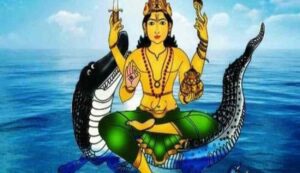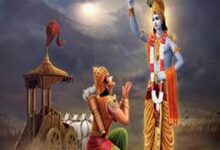Story of Lord Varuna: This god is called for forgiveness and purification, his story is also related to Krishna
Story of Lord Varuna: A key figure in the Vedic faith, Lord Varuna is revered as the cosmic ocean, rain, and water. He is the preserver of life and fertility because of his control over all bodies of water, including rivers, lakes, seas, and the enormous ocean. Varuna is worshipped in the Rig Veda as the ultimate defender of moral and cosmic order in addition to his authority over the material world of water. He is in charge of truth, justice, and the rules that regulate nature and human behavior. He also enforces moral discipline and ties those who deviate from righteousness with his symbolic noose.

Beyond only representing water, Varuna also represents responsibility, law, and sacred vows. He is often called upon for compassion, forgiveness, and cleansing since he is said to be omniscient and to have a thousand eyes looking over the globe. His dual character as a punisher and a forgiver reveals a complex moral theology in which genuine repentance is acceptable in order to gain divine forgiveness. Varuna’s role as the highest sky deity changes in later writings like the Mahabharata and the Ramayana to that of the king of the rivers and the protector of the west, but his cosmic importance and moral authority endure. His emblems, which emphasize his authority over the elements and the moral order of the cosmos, include the noose and the makara, a legendary aquatic monster. Varuna’s lasting legacy is that of a deity who maintains the peace and balance of the cosmos with steadfast justice and compassion, in addition to ruling the waters.
What Lord Varuna Means
Worshipped as the guardian of life, Lord Varuna is in charge of maintaining the earth’s fertility and the harmony of the natural cycles. According to Vedic philosophy, Varuna is an all-powerful entity that watches over the cosmos with a thousand eyes and infinite knowledge. She is also known as the preserver of cosmic and moral order, or rta. He represents a harmony between compassion and discipline by administering justice, punishing those who deviate from dharma, and forgiving those who turn from their ways. By linking him to deeper currents of awareness and spiritual understanding, his associations with the night, the moon, and the west further express his function as the protector of the enigmatic and unseen.
For Sindhi Hindus, Varuna is especially significant since they revere him as Jhulelal, the community’s guardian. During Narali Purnima, fishermen’s communities on the Konkan and Maharashtra coasts pay tribute to him by praying for safety and prosperity and presenting coconuts to the sea. In Buddhist and Jain traditions, he is also highly esteemed; in Japanese Buddhism, he is known as Suiten. He had a significant position in indigenous astrology and was revered as one of the twelve Adityas in ancient Assam. His function as the deity of sailing and water navigation is often highlighted by his depiction in temple art, such as Hoysala architecture.
Lord Varuna is honored at several festivals. Sindhi Hindus celebrate Cheti Chand, which commemorates Jhulelal’s incarnation of Varuna and heralds the arrival of spring. The 40-day Chaliya Sahib celebration is an expression of appreciation to Varuna for answering prayers. Devotees donate coconuts to the sea on Narali Purnima, which falls during the month of Shravan, in order to ask Varuna for good fortune and safe journey. Varuna is also worshipped in certain areas at Raksha Bandhan, when the sea is offered special sacrifices. Varuna is a significant figure in the spiritual and cultural lives of many cultures, and these ceremonies emphasize his ongoing function as a guardian, provider, and upholder of order.
The use of symbols and iconography
A dazzling and magnificent deity, Lord Varuna is sometimes shown with four faces, one of which resembles the fire god, and several exquisite arms. While other sources refer to his skin as golden or black, the Rig Veda depicts it as sky-blue or as dazzling as a conch or crystal. He is shown as being short, strong, and attractive. He is floating while donning powerful golden armor and a sleeveless golden cloak. Varuna is often seen riding a makara, a legendary aquatic animal that has been described as either a fish or a crocodile, or even as having the tail of a fish and the legs of an antelope. In his right hand, he clutches a snake-shaped noose, signifying his ability to bind and uphold cosmic rule. A lotus, a conch, a gem-filled vase, and an umbrella carried over his head are further emblems. His wife Varuni and Riddhi, as well as sometimes his sons Pushkara, Bala, and Sura, accompany him in certain representations. To symbolize his control over all water, he is sometimes seen seated on a glistening diamond throne with the gods of rivers, lakes, and waterfalls around him.
Varuna’s regal and aquatic ties are emphasized in his sculpture, art, and temple representations. He is often seen riding the Makara (Capricorn) in temple imagery.
As the defender of the directions, Varuna or Lokapala, he is seen riding an elephant named Anjana. In several sculptures, he is seen riding a chariot pulled by seven swans, highlighting his association with water and heaven. White robes, pearl decorations, garlands, and a crown are often shown in his pictures, reinforcing his position as a global king. Although his aquatic transport, the noose, and his relationship with water deities and heavenly courts are common aspects, artistic portrayals of him vary by area and time. Varuna’s significance in the cosmic order is further reinforced by his appearance as the defender of the west direction in Hoysala and other temple architecture in South India.
Mudras, stances, and color symbolism are all essential components of Varuna’s iconography. He is often linked to the color white, which stands for clarity, purity, and the water’s capacity to sustain life. White is a common hue in his representations, coupled with pearl and crystal decorations, while other writings have him wearing crimson or yellow robes. He often stands in a blessing position or sits on his car in an erect and magnificent stance. One important representation of his power and capacity to uphold moral standards is the noose he is holding. In keeping with his twin roles as a kind guardian and a disciplinarian, his mudras, particularly the varada (boon) and abhaya (protection) mudras, stand for assurance, forgiveness, and the imparting of benefits.
Lord Varuna’s origin
The oldest Vedic texts provide the legendary roots of Varuna, who is portrayed as the ruler of moral and cosmic order. Varuna is portrayed in the Rig Veda as a supreme god who controls the rules of the cosmos, the motion of celestial bodies, river flow, and natural cycles. He is often called upon to protect justice, forgiveness, and the truth, tying those who disobey these cosmic laws with his noose. He is said to be always on guard, with countless messengers making sure that the universe’s order is never upended.
Varuna’s function as the upholder of cosmic rules is further highlighted in the Brahmana writings. His association with both natural and moral order is emphasized by rituals like the Varunapraghasa Yajna, which is conducted during the rainy season. He is shown as both a punisher and a forgiver, offering atonement via rites and sincere repentance.
As the mythology of the Mahabharata and Ramayana evolves, Varuna’s position shifts from that of the highest sky deity to that of the king of all waterways and the ruler of the west. According to the Mahabharata, he is one of the twelve Adityas, the sons of Aditi, and he lives in a splendid palace under the sea, surrounded by river goddesses and aquatic life. He had significant roles in a number of incidents, including giving King Nala boons and presenting Arjuna with the celestial bow Gandiva and Krishna with the mace Kaumodaki. In another story, Varuna’s susceptibility to a higher moral authority is shown when he is compelled to restore the sage Utathya’s wife after kidnapping her.
Integrity and loyalty to cosmic rules are characteristics of Varuna’s character in the Ramayana. Lord Rama summons Varuna’s penance when he wants to go across the ocean to Lanka. After being silent at first, Varuna ultimately shows up and says that he cannot disrupt the cosmic order by calming the ocean, but he swears not to interfere with Rama’s efforts. Despite divine intervention, Varuna’s steadfast adherence to the principles regulating the cosmos is shown in this episode.
Varuna is portrayed in the Puranas as the protector of the water element and the west. His moral influence endures, punishing those who breach holy order or break vows and rewarding those who uphold the truth, even when his importance wanes in later scriptures. His continuing function as a judge and defender of cosmic equilibrium is reinforced by tales like the torture of King Harishchandra and Krishna’s encounter with Varuna.
Varuna, who represents the twin qualities of justice and mercy, is continuously depicted throughout all of these texts and epics as a heavenly legislator and a caring force. The profound respect for natural order and moral behavior that is at the heart of Hindu cosmology is reflected in his legendary beginning and development.
Stories and legends
The Ramayana tells one of the most well-known tales about Lord Varuna. Lord Rama sought to take his army across the ocean when Ravana kidnapped Sita and carried her to Lanka. Rama prayed for safe passage and spent three days and three nights in intense penance to Varuna, the ocean deity. An angry Rama vowed to destroy the ocean when Varuna did not reply. Varuna came just as Rama was about to employ his divine weapons, expressing his helplessness to alter the rules of the cosmos and pleading for forgiveness. He asked Rama to go after the sea’s wicked animals. Rama’s steadfastness and innocence

